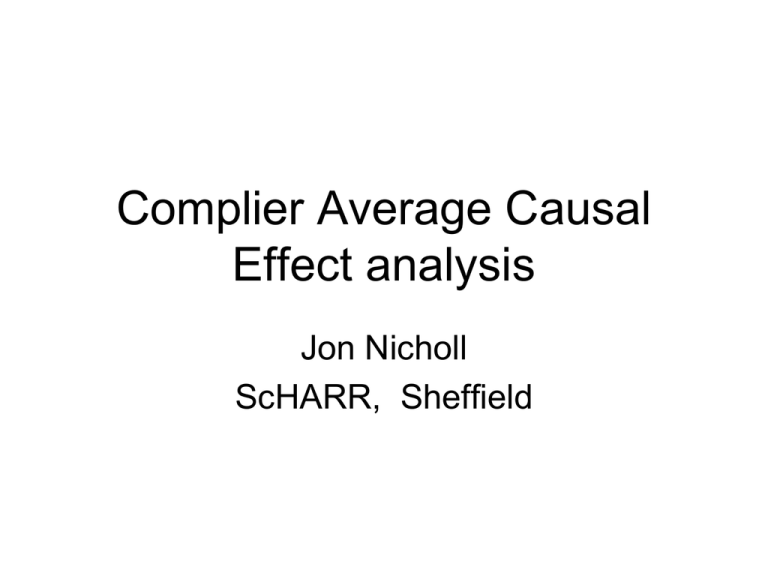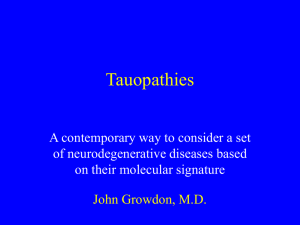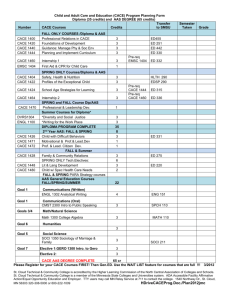to view slides
advertisement

Complier Average Causal Effect analysis Jon Nicholl ScHARR, Sheffield • Pragmatic evaluations allow patients and clinicians to comply with treatment regimes as they would in practice • This often means not completing (adhering to) or following (complying with) the allocated treatment, eg X-overs in surgical trials • ITT analysis of everyone gives a true estimate of the real world population treatment effect, but not of the effect in an individual who is treated (because ITT is diluted by noncompliers) Dealing with non-compliance in TAU or TAU+placebo controlled trials: Complier Average Causal Effect analysis Complied with A Treatment group N Intervention 200 A Control B (TAU) Non-compliers with A All events ER N E ER N E ER 40 0.2 100 30 0.3 300 70 0.233 300 80 0.266 ITT analysis: all A vs all B = 0.233 / 0.266 = 0.875. This estimate is diluted (biased towards 1.0) by the non-compliers • Sometimes the average effect in individuals who comply is estimated by a per protocol analysis Dealing with non-compliance in TAU or TAU+placebo controlled trials: Complier Average Causal Effect analysis Complied with A Treatment group N Intervention 200 A Control B (TAU) Non-compliers with A All events ER N E ER N E ER 40 0.2 100 30 0.3 300 70 0.233 300 80 0.266 ITT analysis: all A vs all B = 0.233 / 0.266 = 0.875. This estimate is diluted (biased towards 1.0) by the non-compliers Per protocol analysis: Complied A vs all B = 0.2 / 0.266 = 0.75 Per protocol analysis • Pointless. It certainly doesn’t work in pragmatic, open trials • And may not in double blind placebo controlled trials Five-year mortality in CHD patients given clofibrate, according to cumulative adherence to protocol prescription. Adherence No of patients Clofibrate Placebo % died No of patients < 80% 357 24.6 ± 2.3 882 28.2 ± 1.5 > 80% 708 15.0 ± 1.3 1813 15.1 ± 0.8 NEJM 1980; 303: 1038- % died Five-year mortality in CHD patients given clofibrate, according to cumulative adherence to protocol prescription. Adherence No of patients Clofibrate Placebo % died No of patients < 80% 357 24.6 ± 2.3 882 28.2 ± 1.5 > 80% 708 15.0 ± 1.3 1813 15.1 ± 0.8 % died 2) Selection by patient preference: Five-year mortality in CHD patients given clofibrate, according to cumulative adherence to protocol prescription. Adherence No of patients Clofibrate Placebo % died No of patients < 80% 357 24.6 ± 2.3 882 28.2 ± 1.5 > 80% 708 15.0 ± 1.3 1813 15.1 ± 0.8 % died The problem is different types of patients have different adherence/compliance rates Can we estimate the control treatment effect in patients who would have complied with A? Dealing with non-compliance in TAU or TAU+placebo controlled trials: Complier Average Causal Effect analysis Complied with A Treatment group N Intervention 200 A Control B (TAU) Non-compliers with A All events ER N E ER N E ER 40 0.2 100 30 0.3 300 70 0.233 300 80 0.266 ? CACE analysis: Complied A vs ER in controls who would have complied with A = 0.2 / ? • Why is this important for cmRCT ? • How does it work? Why is it important? • cmRCT designs randomly select some eligible patients from the cohort to be offered a treatment • For an unbiased analysis all eligible patients offered the treatment are compared with all eligible patients not selected • If the take up of the offer is low, cmRCT designs may seriously underestimate the treatment effect • CACE is a method for adjusting for this How does CACE analysis work? Complied with A Treatment group N Intervention 200 A Control B (TAU) Non-compliers with A All events ER N E ER N E ER 40 0.2 100 30 0.3 300 70 0.233 300 80 0.266 ? CACE analysis: Complied A vs ER in controls who would have complied with A = 0.2 / ? How does CACE analysis work? Treatment group Compliers with A Non-compliers with A All N Intervention 200 A Control B (TAU) 200 events ER N E ER N E ER 40 0.2 100 30 0.3 300 70 0.233 ? 100 300 80 0.266 First, we imagine that there are two types of patient – ‘compliers with A’ and ‘non-compliers with A’. since the trial is randomised, we know (estimate) what % of controls are ‘non-compliers with A’ = 100/300 How does CACE analysis work? Treatment group Compliers with A Non-compliers with A All N Intervention 200 A Control B (TAU) 200 events ER N E ER N E ER 40 0.2 100 30 0.3 300 70 0.233 ? 100 0.3 300 80 0.266 Next, we assume that controls had the same treatment as intervention group A patients who didn’t comply. So the event rate in controls who are ‘non-compliers with A’ would be the same as non-compliers with A given treatment A = 0.3 Is this assumption reasonable? Is this assumption reasonable? • Design: TAU + A vs TAU • Assumption is right • Design: A vs TAU. – Then the question is whether non-compliers with A have TAU or nothing • When non-compliance = X-over the assumption is right • When A = offer of A, and TAU = no offer, then the assumption is also likely to be right unless the offer of A affects outcome • Design: TAU + A vs TAU + placebo. • Then the question is whether there is a placebo effect How does CACE analysis work? Treatment group Compliers with A Non-compliers with A All N Intervention 200 A Control B (TAU) 200 events ER N E ER N E ER 40 0.2 100 30 0.3 300 70 0.233 ? 100 30 0.3 300 80 0.266 Given the event rate, we can now estimate the number of events in the control group who are ‘non-compliers with A’ = 100 x 0.3 = 30 How does CACE analysis work? Treatment group Compliers with A Non-compliers with A All N events ER N E ER N E ER Intervention 200 A 40 0.2 100 30 0.3 300 70 0.233 Control B (TAU) 80 -30 = 50 ? 100 30 0.3 300 80 0.266 200 And, by subtraction, the number of events in the control group who are ‘compliers with A’ How does CACE analysis work? Treatment group Compliers with A Non-compliers with A All N events ER N E ER N E ER Intervention 200 A 40 0.2 100 30 0.3 300 70 0.233 Control B (TAU) 50 ?= 100 50/200 = 0.25 30 0.3 300 80 0.266 200 And hence we can estimate the event rate in the control group who are ‘compliers with A’ How does CACE analysis work? Treatment group Compliers with A Non-compliers with A All N events ER N E ER N E ER Intervention 200 A 40 0.2 100 30 0.3 300 70 0.233 Control B (TAU) 50 ?= 0.25 100 30 0.3 300 80 0.266 200 CACE analysis: Complied A vs ER in controls who would have complied with A = 0.2 / 0.25 = 0.8 How does CACE analysis work? Treatment group Compliers with A Non-compliers with A All N events ER N E ER N E ER Intervention 200 A 40 0.2 100 30 0.3 300 70 0.233 Control B (TAU) 50 ?= 0.25 100 30 0.3 300 80 0.266 200 ITT analysis: All A vs all B = 0.233 / 0.266 = 0.875 Per protocol analysis: Complied A vs all B = 0.2 / 0.266 = 0.75 CACE analysis: Complied A vs ER in controls who would have complied with A = 0.2 / 0.25 = 0.8 The analysis works in the same way for continuous outcomes Compliers with A Non-compliers with A All N Mean outcome N Mean outcome N Mean outcome Intervention 200 A 60.0 100 50.0 300 56.7 Control B (TAU) 53.0 100 50.0 300 52.0 Treatment group 200 (200 x ?) + (100 x 50.0) = 52.0 ITT analysis: All A vs all B = 56.7 – 52.0 = 4.7 Per protocol analysis: Complied A vs all B = 60.0 – 52.0 = 8.0 CACE analysis: Complied A vs ER in controls who would have complied with A = 60.0 – 53.0 = 7.0 CACE was made for cmRCT trials • CACE analysis can be used for A vs TAU trials as in cmRCT designs • It is very helpful for dealing with compliance rather than adherence (ie when patients randomised to treatment don’t take it up at all). This is the case in trials of the offer of treatment - as in cmRCT designs • Some sort of CACE analysis (as opposed to ITT) is essential when compliance is low – as may be the case in cmRCT studies because there is no pre-selection of patients Thank you • Compliance/adherence and CACE analysis: • Hewitt CE, et al. Can Med Assoc J 2006;175:347 (for a simple explanation). • Dunn G, et al. Statistical methods in medical research 2005; 14: 369-395 (for a statistical exploration)










